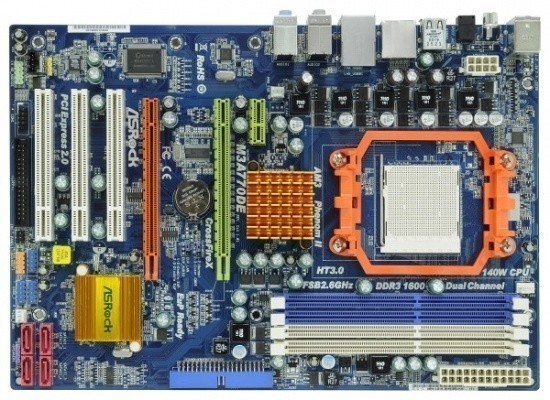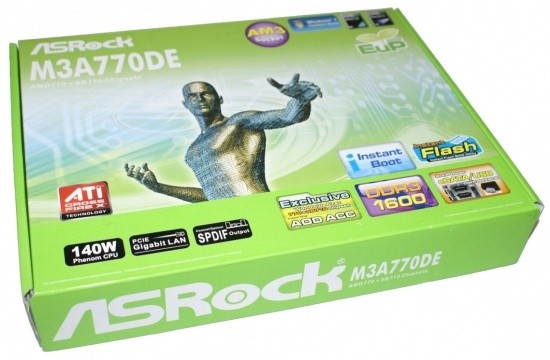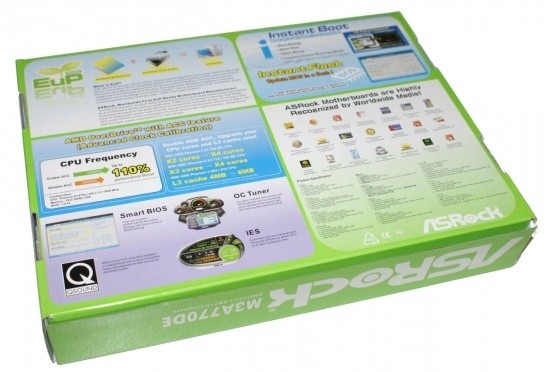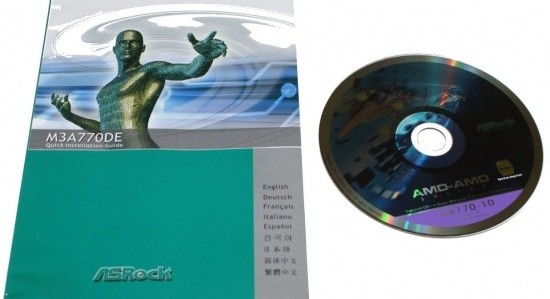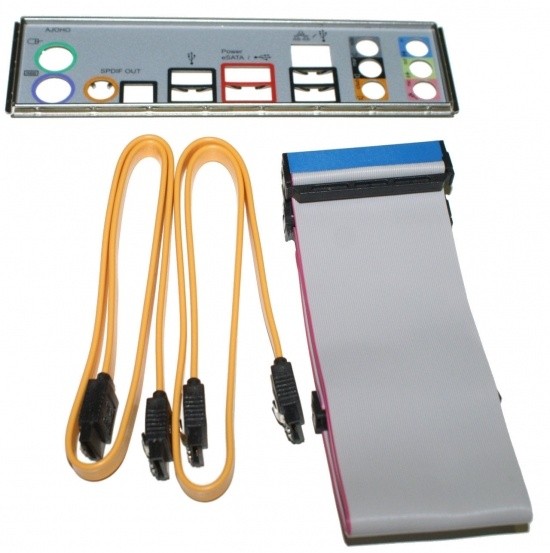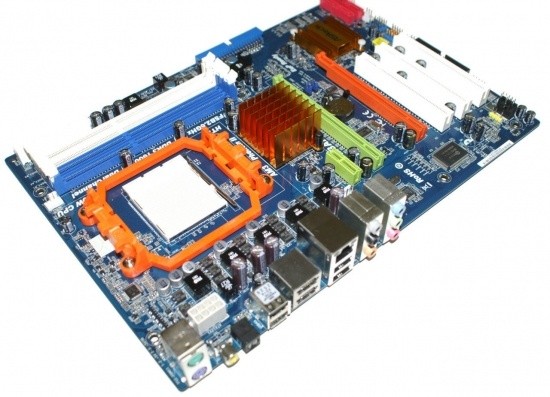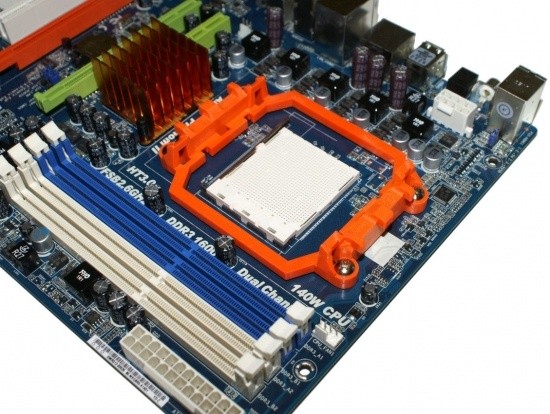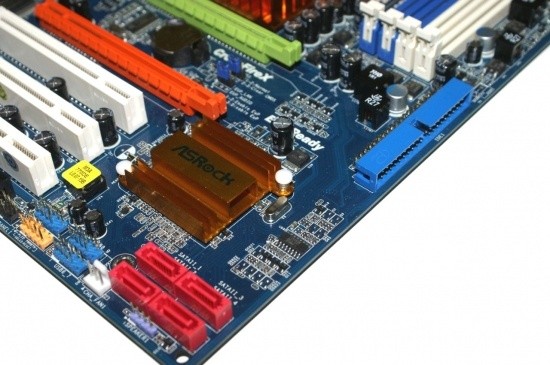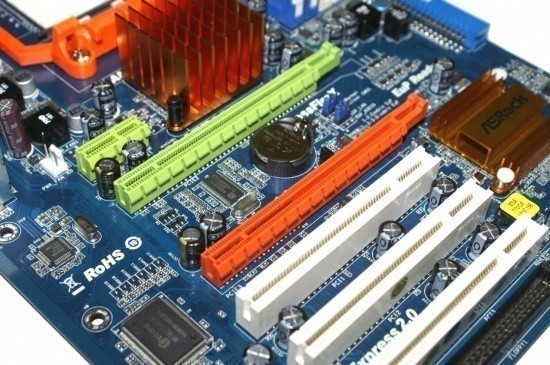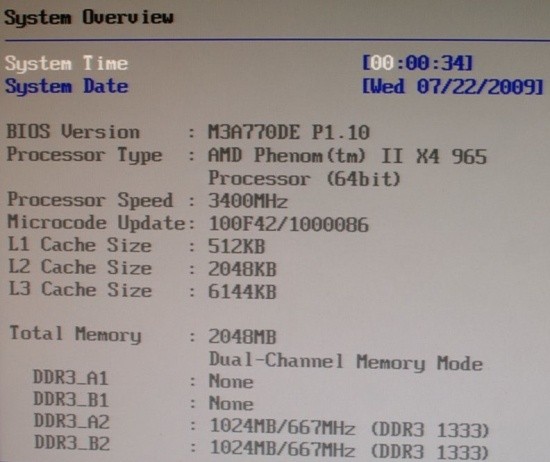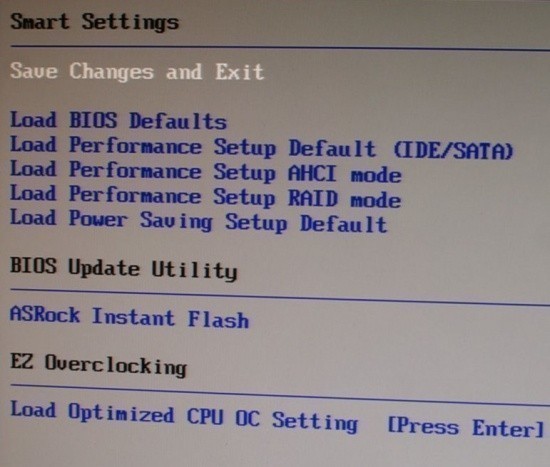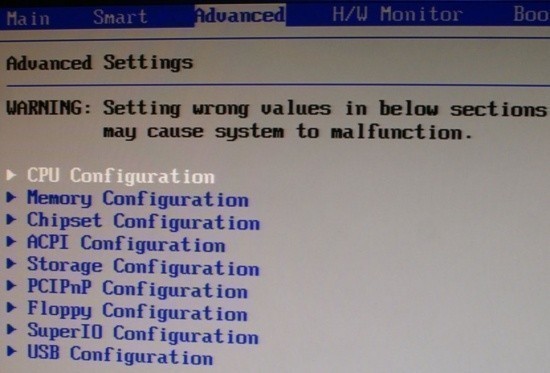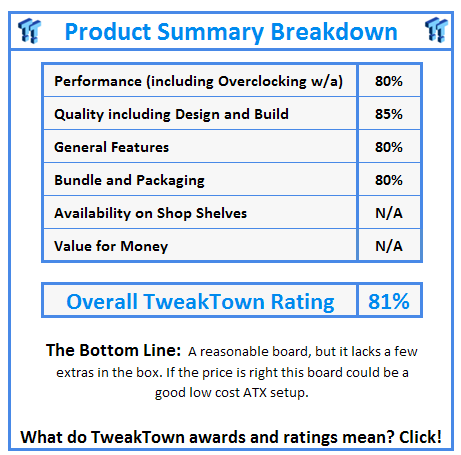Introduction
ASRock has all of a sudden gotten a huge amount of media attention here at TweakTown; that's simply because ASRock has suddenly managed to pump alot more boards out with many different features to market and wants to get them known far and wide.
So far we have already tested X58, P55, 790GX and 785G boards from this company and all have been mighty impressive. Each board has been for a specific segment; X58 for Intel Extreme, P55 for Intel Mainstream, 790GX for high-end AMD and 785G for AMD Mainstream and there are no shortage of models either with two or more boards under each chipset.
In the past ASRock has also been overlooked by the enthusiasts, especially when they were OEM only. However, this has changed over the last two years. ASRock has changed its business model, hoping to attract the overclockers and enthusiasts out there and so far it seems to be working. ASRock boards are actually amongst some of the best overclocking out there and with additional features sometimes packed in such as the first boards to enable four cores on the Phenom tri-core CPU, it's no wonder we are sitting up and taking notice.
Today we have been sent a board aimed more at the mainstream/budget conscious users who don't really want to go hardcore gaming, but for more of a balanced setup. On show today we have the M3A770DE motherboard based around the AMD 770 chipset with SB710 Southbridge.
Unfortunately at the time of writing there are no listings on Newegg for this board, so we can't comment on the price/performance option definitively, but we will update our comments as the board becomes available.
The Box and What's Inside
Package and Contents
Unlike the other two ASRock boards based around AMD's 7 series chipsets, this box is coloured green, the colour of AMD. However, the other two came in a red colour scheme, that of ATI. What's going on I really can't explain, but it's nice to have some variety. On the front there is very little apart from the logos that you'd expect to see.
On the back of the box ASRock puts alot of marketing info on the board's features like EUP, Instant Boot and the AMD overclocking with ACC features. There is no photo of the board itself which is disappointing.
ASRock has gone for a very basic software and document bundle. The user manual is quite thick; however, it's got setup instructions for six different languages, so each language section only gives very basic info on the board. The driver DVD contains drivers for XP and Vista OS's in 32bit and 64bit variants. As of writing this article no Windows 7 drivers are included.
Lastly we get the cables and accessories. This board is clearly aimed more at the mainstream/value segments. There are a total of two SATA data cables and one IDE cable; no FDD cable is included. As normal a rear I/O port shield is included.
The Motherboard
The Board
Now, as we always do we move onto the board. The layout is extremely well designed. ASRock has not gone for the full ATX PCB with this board, rather the standard ATX size. This board can be fit into smaller full tower ATX cases. The 24 pin power connector has been placed behind the four DDR3 memory slots right at the very top edge of the board, a fantastic spot indeed as it keeps the very large ATX cable well out of the way of the CPU and memory modules. The 4/8pin EPS power connector is located behind the S/PDIF output ports on the left hand side.
Using all solid state components for the voltage regulation system, the CPU area is extremely clean of any large components that may block large heatsink installs like we have seen in the past. The CPU is fed power through a 5-phase voltage regulation system to keep things as cool and stable as possible. There are no heatsinks on the Mosfets of this board.
Moving right along, we see the additional storage options that the board includes. The Southbridge used for this board is the AMD SB710, basically the same as the SB750, but lacking any RAID 5 support. This means it does have six SATA ports, only four are available for internal storage. The last two are routed to the two eSATA ports on the rear I/O. A single IDE port is also included for any legacy storage devices such as HDD's and ATAPI devices.
The I/O ports are nothing spectacular or out of the ordinary apart from the inclusion of two eSATA ports which are run off two of the six SATA channels provided by the AMD SB710 chip.
Last on our hit list are the expansion slots. ASRock has managed to get around the lack of Crossfire support that the AMD 770 chipset lacks by using the same tactics that Intel P35 chipsets used to get Crossfire working, a 16/4 configuration. There are two PCIe x16 slots on the board, green and orange. The green one is connected to the AMD 770 Northbridge and has a constant 16 lanes running to it, whilst the orange slot is a x4 electrically connected slot to 4 of the 6 lanes the SB710 supports. This gives the board Crossfire support, but lacks the full speed that even an 8/8 setup would give. There is a single PCIe x1 slot above the upper x16 slot for PCIe connectivity and three PCI legacy slots for additional connectivity.
BIOS and Overclocking
BIOS
ASRock uses the same BIOS style as ASUS and Intel used for their own boards, so if you have used these boards in the past (as I am sure most have), this BIOS will feel quite familiar to you.
If you're a first time user or just someone who doesn't want to mess around with all the settings in BIOS, ASRock places under the Smart menu a set of pre-determined overclock profiles to help you setup your system as quick as possible.
If you are more into tweaking yourself, this board gives you quite a bit of freedom. Under the advanced menu are all the sub menus allowing you to tweak CPU, memory and voltages to some pretty high numbers.
Overclocking
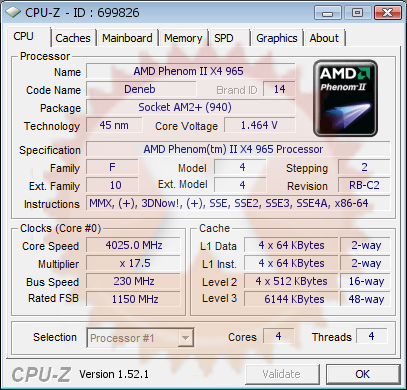
Despite all the tweaking functions, this board was limited to 230MHz FSB. While this did clock our CPU to 4GHz stable, we hoped to see more; especially compared to AMD 785G which we managed to get to 300MHz from easily.
You can see the validation here.
As all overclocking results are dependent on the hardware you use, your results may vary. Results of our overclocking tests are included in the performance section with the stock scores.
Important Editor Note: Our maximum overclocking result is the best result we managed in our limited time of testing the motherboard. Due to time constraints we weren't able to tweak the motherboard to the absolute maximum and find the highest possible FSB, as this could take days to find properly. We do however spend at least a few hours overclocking every motherboard to try and find the highest possible overclock in that time frame. You may or may not be able to overclock higher if you spend more time tweaking or as new BIOS updates are released. "Burn-in" time might also come into play if you believe in that.
Test System Setup and Comments
Test System
Processor: AMD Phenom II 965
Memory: 2GB Kingston KHX12800D3T1K3/3GX (Supplied by Kingston)
Hard Disk: Intel X25-M 80GB SSD (Supplied by Intel)
Graphics Card: GIGABYTE GTX285 1GB (Supplied by GIGABYTE)
Cooling: Cooler Master Hyper 212 (with an extra fan) (Supplied by Cooler Master)
Operating System: Microsoft Windows 7 Ultimate RTM x64
Drivers: ATI Catalyst 9.8. ForceWare 190.62
Comments
Everything on the ASRock M3A770DE board worked as it should and we had no compatibility issues. Windows 7 RTM x64 loaded without any problems and all the drivers were installed as normal. We ran our suites with stock and overclocked settings to see how things changed with a few extra MHz and compared them to our reference 785GX board from ASRock also.
Synthetic Tests - Part I
Memory Bandwidth
As with any system you will want to see a combination of synthetic testing and real-world. Synthetics give you a static, easily repeatable testing method that can be compared across multiple platforms. For our synthetic tests we use Everest Ultimate, Sisoft Sandra, Futuremark's 3D Mark Vantage and PCMark Vantage, as well as CINEBENCH and HyperPi. Each of these covers a different aspect of performance or a different angle of a certain type of performance.
Memory is a big part of current system performance. In most systems slow or flaky memory performance will impact almost every type of application you run. To test memory we use a combination of Sisoft Sandra, Everest and HyperPi 0.99.
Everest Ultimate
Version and / or Patch Used: 5.02.1789
Developer Homepage: http://www.lavalys.com
Product Homepage: http://www.lavalys.com
Buy It Here
Everest Ultimate is a suite of tests and utilities that can be used for system diagnostics and testing. For our purposes here we use their memory bandwidth test and see what the theoretical performance is.
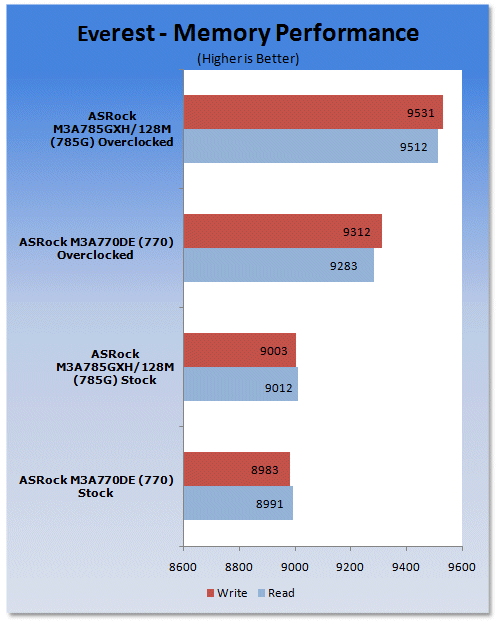
At stock clock speeds there is no difference between the three different platforms. However, when we overclock we see that the AMD 770 is quite capable, but still not able to outperform the higher end chipsets.
Sisoft Sandra
Version and / or Patch Used: 2009 SP3c
Developer Homepage: http://www.sisoftware.net
Product Homepage: http://www.sisoftware.net
Buy It Here
SiSoft Sandra (System ANalyser, Diagnostic and Reporting Assistant) is a synthetic Windows benchmark that features different tests used to evaluate different PC subsystems.
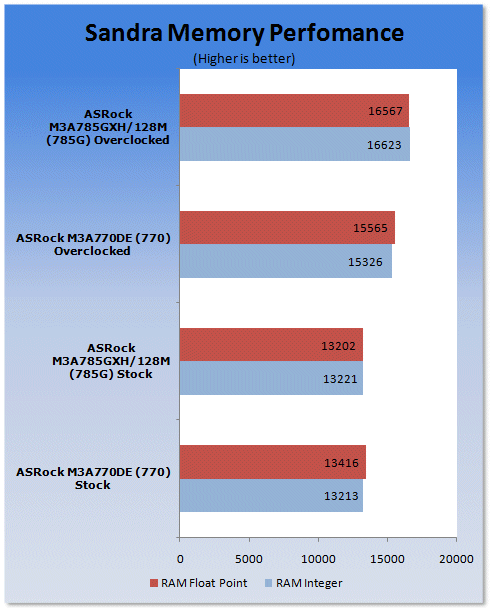
Again, more synthetic memory performance shows similar results to Everest.
HyperPi 0.99
Version and / or Patch Used: 0.99
Developer Homepage: www.virgilioborges.com.br
Product Homepage: www.virgilioborges.com.br
Download It Here
HyperPi is a front end for SuperPi that allows for multiple concurrent instances of SuperPi to be run on each core recognized by the system. It is very dependent on CPU to memory to HDD speed. The faster these components the faster it is able to figure out the number Pi to the selected length. For our testing we use the 32M run. This means that each of the four physical and four logical cores for the i7 is trying to calculate the number Pi out to 32 million decimal places. Each "run" is a comparative to ensure accuracy, and any stability or performance issues in the loop mentioned above will cause errors in calculation.

HyperPi shows very little between the three platforms at stock and when overclocking there isn't much of a gap either.
Synthetic Tests - Part II
Disk Drive Controller
The system drive controller is an important part of system performance. In most modern boards your drive controller will run off of the PCI-e bus. The PCI-e bus performance can be affected by poor trace layout as well as many other design choices that show up on different boards.
For testing we use both Everest and Sisoft's Sandra.
Everest
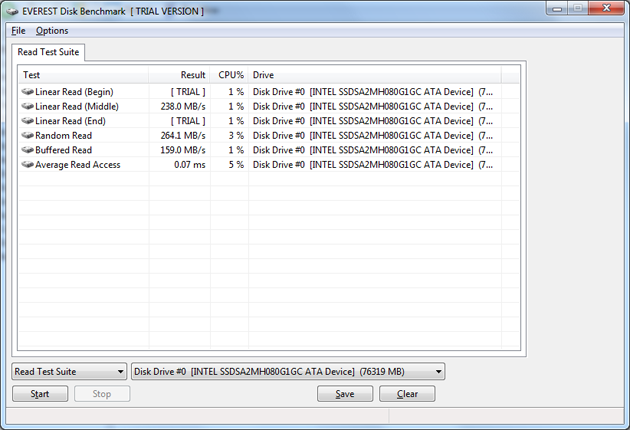
Stock Memory Performance
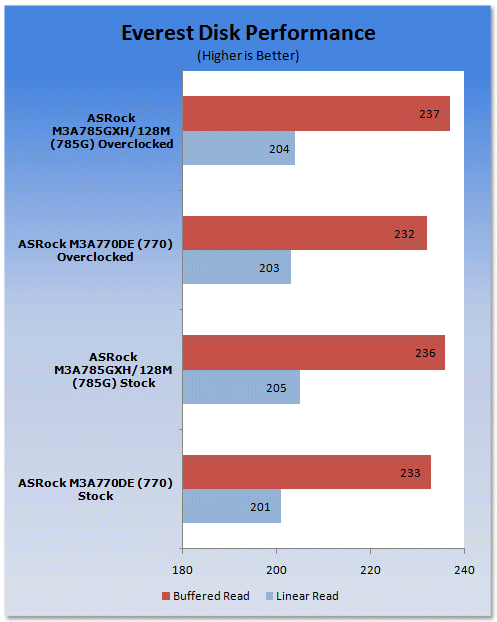
Under Everest we look at disk performance and despite using a different Southbridge the performance is equal across all three platforms.
Sandra
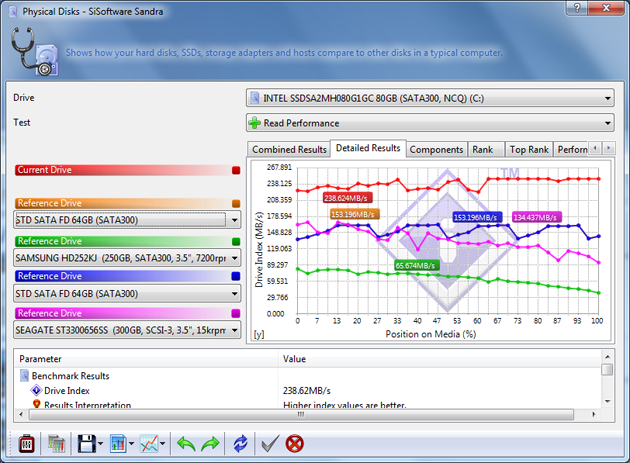
Stock Memory Performance
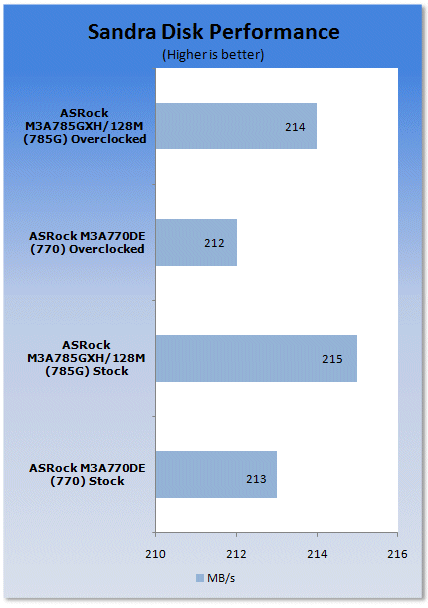
Again with Sandra we see the same trend as Everest.
Synthetic Tests - Part III
Overall System performance and Gaming
Here is where we dig out the FutureMark tests followed by CINEBENCH.
PCMark Vantage
Version and / or Patch Used: 1.0.0.0
Developer Homepage: http://www.futuremark.com/
Product Homepage: www.futuremark.com
Buy It Here
For overall system performance we use PCMark Vantage; this is run in both x86 and x64 mode to give the best indication of performance.
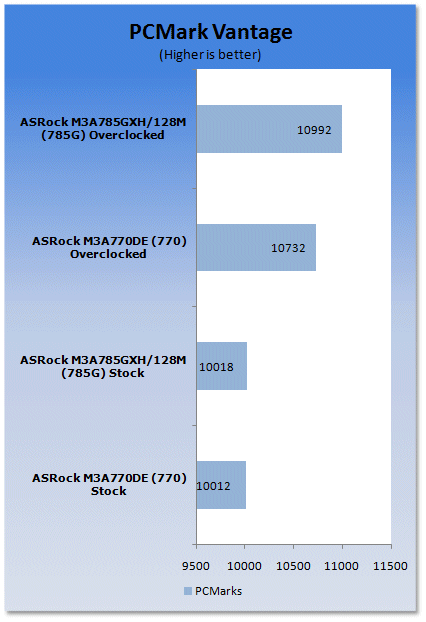
Moving into synthetic system tests we see that the AMD 770 ASRock board is quite competitive.
3DMark Vantage
Version and / or Patch Used: 1.0.1
Developer Homepage: http://www.futuremark.com/
Product Homepage: www.futuremark.com
Buy It Here
For synthetic gaming tests we used the industry standard and overlockers bragging tool, 3DMark Vantage. This is a test that strives to mimic the impact modern games have on a system. FutureMark went a long way to change from the early days of graphics driven tests to a broader approach including physics, AI and more advanced graphics simulations. 3DMark Vantage uses the DX10 API in addition to having support for PhysX.
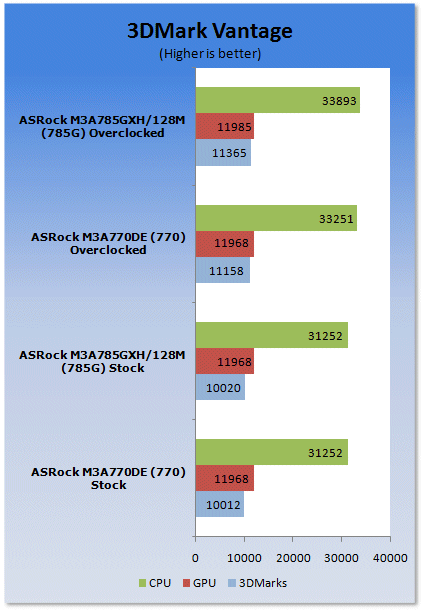
Under synthetic gaming we see that the ASRock 770 chipset board only falls behind when overclocking.
CINEBENCH R10 x64
Version and / or Patch Used: R10
Developer Homepage: http://www.maxon.net/
Product Homepage: www.maxon.net
Download It Here
CINEBENCH is a synthetic rendering tool developed by Maxon. Maxon is the same company that developed Cinema4D another industry leading 3D Animation application. Cinebench R10 tests your systems ability to render across a single and multiple CPU cores. It also tests your systems ability to process OpenGL information.
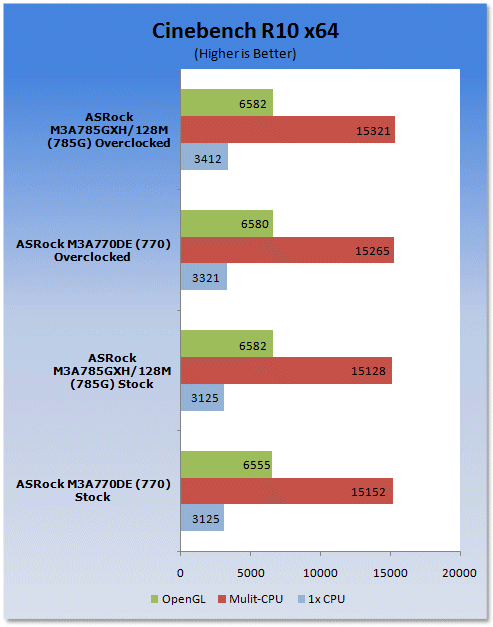
Last on our synthetic tests we see that the AMD 770 board isn't that far behind at the overclocking stages.
Real-World Tests Part I
Real-world testing allows us to see how well a product will perform when used in the same manner as it would be in your house or office. It is an important side to performance testing as it can uncover hidden glitches in the way a product performs.
It is especially true when testing a mainboard; there are so many components of a board that have to interact that any problems between parts can cause a failure of the whole.
For real-world testing we use some common applications and functions. We test with LightWave 3D for rendering performance, AutoGK for transcoding from DVD to AVI and two games for gaming testing.
Rendering
Rendering of 3D animation is a system intensive endeavor. You need a good CPU, memory and HDD speed to get good rendering times. For our testing we use LightWave 3D. This software from Newtek is an industry standard and has several pre-loaded scenes for us to use.
LightWave 3D
Version and / or Patch Used: 9.6
Developer Homepage: http://www.newtek.com
Product Homepage: http://www.newtek.com/lightwave/
Buy It Here
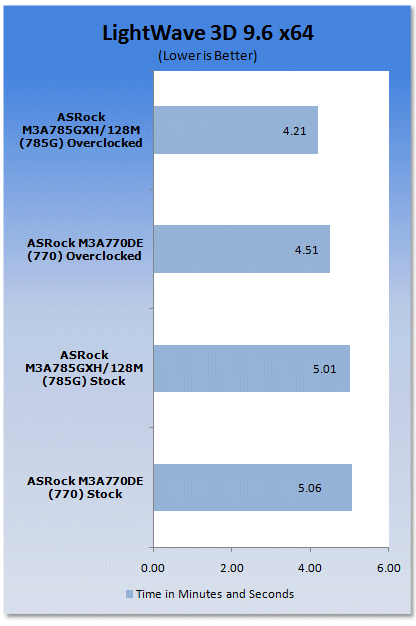
In real world rendering tests we see that the AMD 770 ASRock is only losing out when overclocking comes into it.
AutoGK
Version and / or Patch Used: 2.55
Developer Homepage: http://www.autogk.me.uk/
Product Homepage: http://www.autogk.me.uk/
Download It Here
AutoGK stands for Auto Gordian Knot; it is a suite of transcoding tools that are compiled into and easy to install and use utility. It allows you to transcode non-protected DVDs and other media to Xvid or DivX format. For our testing purposes we use a non-DRM restricted movie that is roughly 2 hours in length. This is transcoded to a single Xvid AVI at 100% quality.
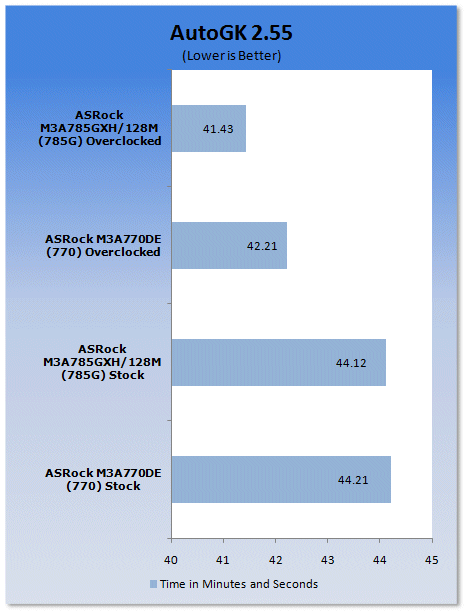
In video transcoding the AMD 770 ASRock board falls slightly behind the pack when encoding.
Real-World Tests Part II
Here we have our real gaming tests. Each of the games we chose use multiple cores and GPUs. They are able to stress the system through use of good AI. Both have decent positional audio that adds impact to the sound subsystem of the board. We ran each game through the level or parts listed and recorded frames per second using FRAPS. This brings the whole game into play.
Cryostasis: Sleep of Reason
Version and / or Patch Used: 1.0
Timedemo or Level Used: From Ship Entry until third Spirit Journey
Developer Homepage: http://www.505games.co.uk
Product Homepage: http://cryostasis-game.com
Buy It Here
Cryostasis : Sleep of Reason is an interesting game it is heavy on PhysX so to play it properly you will really want an NVIDIA GPU. However, with that aside it can be immersive. Imagine MYST with guns and monsters. One of the cool concepts is the spirit journeys. These allow you to enter the past of lost souls. You have to change their past to change your future. Each one makes for a nice diversion and requires you to think about what you are doing and how it will affect the outcome of the game. The settings we used are shown below.
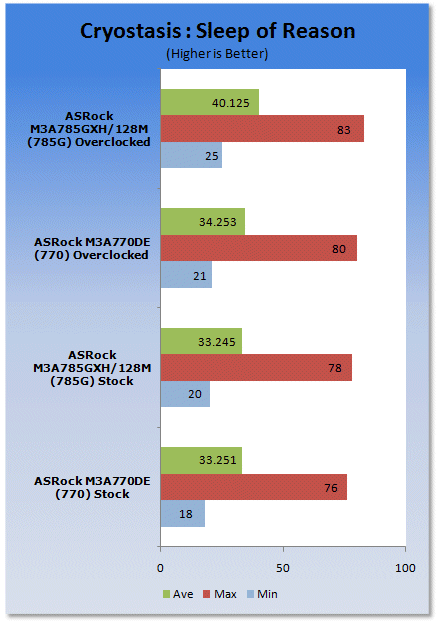
As you can see, single card performance was more than acceptable if you account for the human eye only being able to register 32FP/s, so you have full fluid motion with this game even at 1920x1200 and all the eye candy turned on. ASRock's 770 chipset board performs quite well; even at overclocked speed there isn't really much difference at all.
Far Cry 2
Version and / or Patch Used: V1.00
Timedemo or Level Used: Clearing the Safe house through to the Rescue
Developer Homepage: http://www.ubi.com
Product Homepage: http://farcry.us.ubi.com
Buy It Here
Far Cry 2 is a large sandbox style game. There are no levels here, so as you move about the island you are on you do not have to wait for the "loading" sign to go away. It is mission driven so each mission is what you would normally think of as the next "level". In the game you take the role of a mercenary who has been sent to kill the Jackal. Unfortunately your malaria kicks in and you end up being found by him. Long story short, you become the errand boy for a local militia leader and run all over the island doing his bidding. The settings we used for testing are shown below.
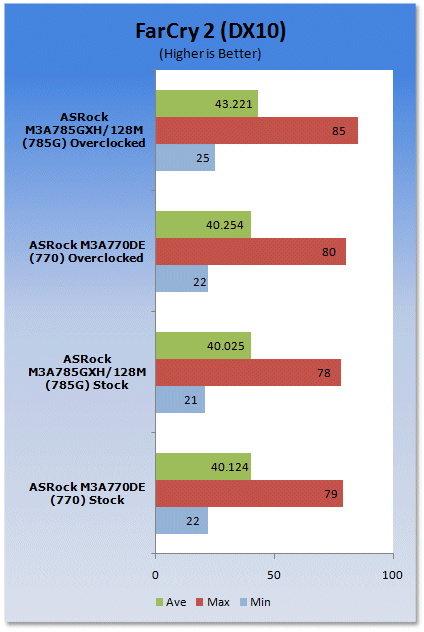
Lastly in gaming we see that no matter what board you choose the AMD 770 can hold its own in real world gaming.
Power Usage and Heat Tests
Power Consumption
We are now able to find out what kind of power is being used by our test system and the associated graphics cards installed. Keep in mind; it tests the complete system (minus LCD monitor, which is plugged directly into an AC wall socket).
The power consumption of the X58 Extreme from ASRock with the i7 975 at idle was not too bad. It is actually a little less than what I have seen from a Core 2 Quad running on a X48 board. What is a little bothersome is the huge delta between idle and load power consumption. We saw the power draw from the wall jump over 130 watts in each case. So the X58 Extreme is a power efficient when it is resting but not so much when you need to put it to work.
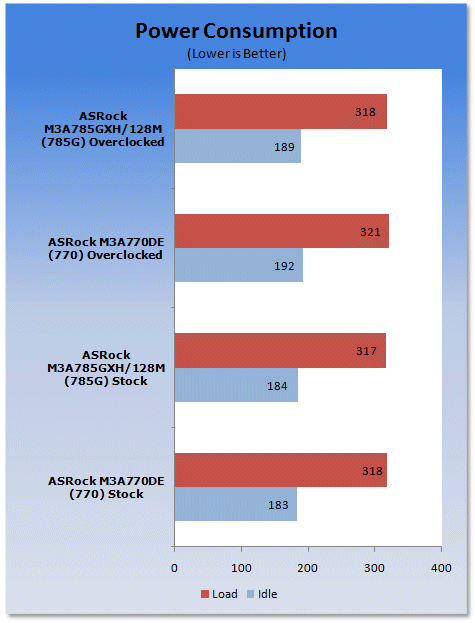
With regard to power consumption the AMD 770 chipset is built on the same micron process as the other chipsets used and holds out quite well.
Heat Generation
As a new measure, we are now monitoring the heat generation from the key components on the motherboards; this being the Northbridge, Southbridge (if it contains one) as well as the Mosfets around the CPU. The results are recorded at idle and load during the power consumption tests.
Heat is not too bad here and is about what you would expect given the cooling system used. Bear in mind that these readings were taken on an open system. Once you put the X58 Extreme into a case and close it up these temps will certainly go up. This is especially true if you choose to use water cooling as the heat pipe system will have to rely on air movement from any case fans you may have.
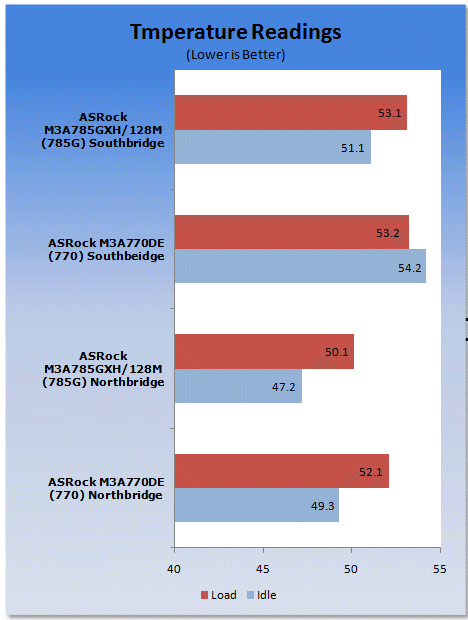
In terms of heat generated, the ASRock 770 board doesn't use any major cooling linkages which doesn't dissipate heat as evenly as the other boards tests.
Final Thoughts
AMD's lineup of chipsets for their own platform is extremely impressive; in fact, they have in this reviewers eyes totally surpassed any products that NVIDIA has managed to put out there. Unlike Intel, AMD isn't holding back any licensing agreements for their CPU's which gives NVIDIA free reign to produce anything for AMD. However, as of lately we have seen nothing new come from NVIDIA for AMD and it seems they aren't going to compete with AMD to get SLI setups going; very strange indeed.
AMD on the other hand is pushing forward ever so fiercely with their chipsets in the 7 series. We have already got four majors and now with 770 we have a 5th chipset all for the AMD K8 and K10 families. In all, nothing short of fantastic. Intel has their own chipsets and won't license NVIDIA to produce any desktop chipsets for Quick Path.
ASRock has once again produced a very impressive board. While the software and accessories were lacking, this board is only a value to mainstream at best product and as such the extras resemble this. Overall, the performance was well on target.Overclocking could have been better, but this could be the chipset and not the board. Time will only tell.

